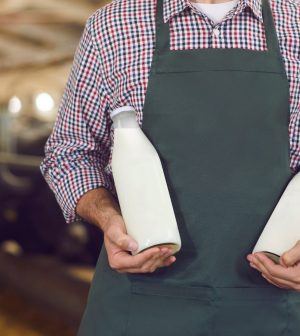- Understanding the Connection Between Anxiety and Depression
- How Daily Prunes Can Influence Cholesterol and Inflammation
- When to Take B12 for Better Absorption and Energy
- Epsom Salts: Health Benefits and Uses
- See What Saffron Can Do for Sleep and Heart Health
- 6 Common Mistakes to Avoid Before Your Physical
- Can Sweating Really Help You Beat a Cold?
- Strengthening Your Relationship: Practical Strategies
- Skip Storing This Everyday Product in the Fridge Door
- Green Tea + B3 Pairing May Boost Brain Health
In Experiments, Mice Got Ill From Raw Milk Carrying Bird Flu Virus

Confirming the dangers of drinking raw cow’s milk when the H5N1 avian flu virus is circulating in U.S. dairy herds, researchers found that mice fed the milk quickly got ill.
“Our data indicate that HPAI A[H5N1] virus in untreated milk can infect susceptible animals that consume it,” concluded a team led by virologist Yoshihiro Kawaoka, of the University of Wisconsin–Madison. His team published the findings Friday in the New England Journal of Medicine.
In late March, researchers first detected traces of H5N1 bird flu in nasal swabs and milk obtained from U.S. dairy cows. Since then, the outbreak has been detected in many dairy herds across multiple states.
So far, H5N1 does not seem to transmit easily between animals and humans: There have been only two known human cases of H5N1 infection linked to the U.S. dairy cow outbreak. Both have occurred in dairy workers who have had extended, close contact with the animals.
Experts also believe the general milk supply to be safe, since the heating involved in pasteurization kills the virus.
However, drinking unpasteurized “raw” milk — a craze among a small subset of consumers — may, in fact, run the risk of passing H5N1 to other mammals, including people.
To find out if that is true, Kawaoka and his team gave mice raw cow’s milk known to be contaminated with the H5N1 virus. The rodents received the milk by mouth.
The mice showed typical signs of infection, such as “ruffled fur and lethargy” as soon as one day after being fed the milk, the researchers reported.
“All the animals survived until day 4, when they were euthanized to determine virus titers [levels] in multiple organs,” Kawaoka’s group said.
“We detected high virus titers in the respiratory organs [which suggests that infection may have occurred through the pharynx] and moderate virus titers in several other organs, findings consistent with the systemic infections typically caused by HPAI H5 viruses in mammals,” the team reported.
High levels of virus were also found in the female mice’s mammary glands, even though they were not lactating, the researchers said.
Based on their findings, the researchers believe that mammalian infection with the avian flu virus can happen after consuming cow’s milk containing the pathogen if the milk has not been heat-treated, as happens with pasteurization.
People who drink raw milk may believe that refrigeration can kill off the H5N1 virus. The researchers investigated that notion, refrigerating the infected milk at a temperature of 39 degrees Fahrenheit.
However, levels of virus in the unpasteurized milk declined only slowly while kept at this temperature for five weeks, suggesting that the “virus may therefore remain infectious for several weeks” under these conditions, according to the researchers.
As for pasteurization, the scientists put raw, infected milk through heating processes similar to those used in the pasteurization process. They report that levels of virus were reduced to undetectable or barely detectable levels, but in some cases not completely eliminated.
Kawaoka’s team stressed that “the conditions used in our laboratory study are not identical to the large-scale industrial [pasteurization] treatment of raw milk.”
Still, the research seems to confirm that the real danger of passing H5N1 onto consumers lies in the consumption of raw milk.
“Don’t drink raw milk — that’s the message,” Kawaoka told the New York TImes.
And there are more reasons than bird flu to avoid raw milk.
According to one 2022 study from the U.S. Centers for Disease Control and Prevention, raw milk consumption has been linked to 228 hospitalizations, three deaths and illness in more than 2,600 people between 1998 and 2018.
More information
The CDC has more on the dangers of consuming raw milk.
SOURCES: New England Journal of Medicine, May 24, 2024; New York Times
Source: HealthDay
Copyright © 2026 HealthDay. All rights reserved.










